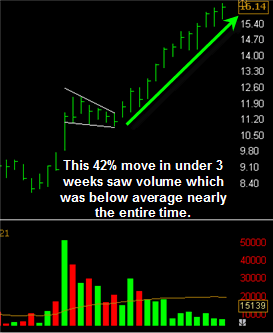Stop Loss Placement, Part 4
August 6, 2009 at 8:50 pm
As we complete this series on stop loss placement, we’re going to discuss trailing stops. But be sure to catch Part 1, Part 2 and Part 3 first!
In this segment, I specifically want to discuss the importance of managing our risk throughout a trade, not only to reduce losses but also to preserve profits. This is achieved by adjusting our stop, or through the use of a trailing stop.
When and Why to Adjust a Stop Loss
A rock climber knows the importance of anchoring himself to the wall along the way up, just in case he happens to slip. The anchor set early in the climb at a low altitude is every bit as important as the ones set at higher levels, but the more a climber ascends, the less useful a low anchor will become. As a result, it’s wise to keep raising it along the way.
Trading is similar in that the stop loss we initially set for a position may not be appropriate once that trade has progressed, so it’s likely to need adjusting along the way.
Setting some rules for ourselves, sticking with them consistently, and maintaining an adequate reward-to-risk structure throughout the trade can keep us in good shape.
Watch this clip and let me explain more thoroughly with some specific examples. It was also posted over at the Trading Videos site, but I’ve embedded it here for your convenience.
Let me highly suggest clicking the “HD” on the video player and then going full-screen for best quality.
Update: Check out Part 1, Part 2 and Part 3 of this series!
Thanks for stopping by and I’ll see you here soon with more. Until then…
Trade Like a Bandit!
Jeff White
Are you following me on Twitter yet?
Stop Loss Placement, Part 3
August 5, 2009 at 8:44 pm
To continue the series on stop loss placement, it’s time that we build on both Part 1 and Part 2 by taking things a step further.
In this segment, I specifically want to clarify a major advantage of basing our stops on the chart. Of course we’ll know where to get out if the pattern happens to fail, but there’s one thing many traders fail to focus on in relation to that. It’s an equation, and a simple one, but it gives us our position size.
Dollar Risk Per Trade
If every stock were the same price and carried with it the same volatility, and if every pattern we traded happened to carry the same exact chart scenarios, Part 3 of this discussion wouldn’t exist.
But each stock is a little different than the next. Each setup will vary from the previous one we entered. And of course, the distance from our entry to stop isn’t going to be the exact same from one trade to the next.
So what we need to do if we want to maintain a consistent dollar risk per trade is to determine an amount we’re willing to lose on each trade in case we are wrong. Let’s face it, some trades aren’t gonna work, and we’re going to get stopped out.
Once we know how much we’ll be willing to risk (in terms of a set $ amount, or a set % of our account value), then we can combine that into a simple equation to give us our position size.
$ Risk Per Trade / Distance from Entry to Stop = Position Size
Watch this clip and let me explain more thoroughly with some specific examples. It was also posted over at the Trading Videos site, but I’ve embedded it here for your convenience.
And if you have questions pertaining to stops, add them to the comments section or contact me directly and I’ll try to work those into the next few segments.
Let me highly suggest clicking the “HD” on the video player and then going full-screen for best quality.
Update: Check out Part 1, Part 2 and Part 4 of this series!
Thanks for stopping by and I’ll see you here soon with more. Until then…
Trade Like a Bandit!
Jeff White
Are you following me on Twitter yet?
Scale Out of Winning Trades with Partial Exits
August 4, 2009 at 12:55 pm
It’s common among traders to think that you either have to be all-in with a stock or all-out of a stock, but that sure isn’t the case.
Many of us do our buying in one piece, entering a full position at one time as an important level gets crossed. This is my personal preference, as I continually seek out trading opportunities where a ceiling is shattered or a floor implodes, enabling price to make a nice move through it.
And when I am wrong (yes, when, not if ), I’ll exit in one piece. As events occur or conditions emerge to show me that the stock is clearly moving in the opposite direction of what I had expected, I’m going to bail out of the trade and protect capital.
So, I’m getting into trades in one piece, and I’ll stop out of trades in one piece. But rarely will I exit a winning trade in just one piece. Instead, I’ll scale out.
Advantages of Incremental Profit-Taking
Over the years in dealing with traders from literally around the globe, I’ve found that very few of them will get out of favorable trades in pieces. Adopting this method of booking profits can be an excellent way to trade, and particularly in a momentum-based market like the one we currently find ourselves in.
Taking partial profits and peeling off a portion of your position on the way up carries with it several advantages. Let’s look at a few…
1. You can lighten your exposure into favorable moves. As your trade makes its move, it’s a great idea to start reducing your position size. The idea is that as a move progresses, it naturally becomes more difficult to capture similar returns to the initial move. Typically stocks surge early, so this is a way to take advantage of that early momentum.
2. Make room for new opportunities. This isn’t just for those who may be trading with a smaller account and need to raise cash to put toward a new play. In fact, even traders with larger accounts may find it difficult to manage a lot of positions in terms of the attention they can devote to each trade. Catching the move you initially were seeking can remind you that it may be time to shed some shares and seek out another stock to put your money and/or attention into.
3. Let slippage work in your favor. Posting offers on the way up means you’re capturing the bid/ask spread – not paying it. I use market orders for entries and for stopping out, because when I need to be in or out of a trade I don’t want to haggle over a few cents. But when it comes to booking profits, limit orders resting at higher levels mean you’re out there offering out some inventory, letting someone else pay up for it.
4. Satisfy the urge to take cash off the table, yet still stand to gain from a continued move. This is a big confidence booster as well as a way to manage money wisely. Turning some of those paper gains into real profits not only pads your account, but it also reinforces that you’re on the right track. Gaining some momentum in your trading is a great thing, both for your account and for your psyche. And by adjusting the stop for remaining shares, keeping even a portion or a core position allows you to benefit from a major move, should it occur.
Trade Like a Surfer
Just as a surfer catches one wave after another, a good trader maintains the same mentality. Ride the best moves you can find, but don’t be shy about easing out of a trade once you’ve caught a nice move. Paddling back out to locate the next one will require your availability, so when you start smiling about a trade, it’s probably time to start scaling out.
The fear of missing out on a giant run keeps many traders from selling at all, but scaling out carries with it the best of both worlds.
Consider making partial sales in your next winning trade, and see what it does for your bottom line. It just might be the best adjustment you make this year.
Thanks for stopping by and I’ll see you here soon with more. Until then…
Trade Like a Bandit!
Jeff White
Are you following me on Twitter yet?
Momentum Trading – A Different Mindset
August 3, 2009 at 7:17 am
After a lengthy period of indecisive, range-bound price action, we’ve seen the market gather some momentum in recent weeks. The push from the July low was rapid and relentless – clearly a change of character.
The landscape tends to shift like that from time to time. Sometimes key levels serve as steadfast boundaries for price and don’t allow it to gather any steam in either direction. But at other times, we’re in a run-and-gun market where we get trend days after trend days, and follow through is far easier to come by.
Let me be clear though: that doesn’t mean it’s easy.
In fact, the momentum game really requires a different kind of mindset for success. Dare I say, it can be much tougher on the experienced trader.
Let me explain why.
Mindsets of the Amateur and the Adept
First, let’s examine the novice. Generally, their approach can be quite simple…
See green, go long.
See red, sell.
Often times, they may not even consider how much green they’ve just seen – all they know is that there’s strength present, so they buy without concern.
This mentality contributes to the momentum, and when it’s particularly strong, they make money without much stress. Soon they’re saying, “I think I might quit my day job!”
On the other hand is the experienced trader. A guy like me finds it particularly difficult to chase stocks, because in my post-beginner trading phases I’ve bought the top or sold the low. It isn’t fun. Experiences like that can leave you a little gun shy, and it becomes a habit to recognize at which point a play has moved too far for a new entry. Thoughts creep in, such as “Is this market ever gonna rest?”
So, seeing a stock which just ran 5% intraday, for example, leaves me far more likely to respond with an I’ll catch the next move mentality. I know how nice it is to have some inventory to flip out to those late-comers after a big pop, so when moves start getting extended, my preference is to start lightening up instead of adding.
This “I forgot my track shoes today, so I won’t be a chaser” mentality might frequently serve to help me protect capital, but during those times when powerful momentum is present, it can actually cost me opportunities.
Shifting Gears
Knowing this, how bout we take a look at 3 ways to identify and trade momentum. That could help us adjust when the conditions warrant hopping on board the train when it’s already in motion.
1. Recognize a change of character. Paying close attention to the environment you’re trading in will make it more obvious that your approach should change accordingly. Perhaps recent advances have been 3-4%, and suddenly a 6% move arrives and shows no signs of fatigue. That’s a change of character, and it’s a signal to shelve your current strategy for the time being. And if you don’t have another style to turn to, then it’s time to seek out another way to profit.
 2. Watch the volume. Under normal circumstances, even with a trend, we can compare upside volume to downside volume and notice some patterns emerging. For example, an uptrend might see spurts of strength accompanied by higher volume, and periods of rest accompanied by lighter volume. But when real momentum arrives, the volume may not follow that same pattern. Price simply gets on the move and keeps the pedal to the metal, and volume doesn’t have to play a major role. Market participants are simply caught off guard, and there’s a persistent move as they jockey for position. Many times that results in consistent volume levels which don’t surge and contract like they do during a rally-rest-rally type of phase.
2. Watch the volume. Under normal circumstances, even with a trend, we can compare upside volume to downside volume and notice some patterns emerging. For example, an uptrend might see spurts of strength accompanied by higher volume, and periods of rest accompanied by lighter volume. But when real momentum arrives, the volume may not follow that same pattern. Price simply gets on the move and keeps the pedal to the metal, and volume doesn’t have to play a major role. Market participants are simply caught off guard, and there’s a persistent move as they jockey for position. Many times that results in consistent volume levels which don’t surge and contract like they do during a rally-rest-rally type of phase.
3. Notice when a pause is ignored. If you’ve been trading for almost any length of time, you’ll notice times when price starts to get a little stretched and is getting due for a rest. If that rest is not allowed, then momentum is definitely present. Lace up those running shoes, you’re probably gonna need ’em.
Emotion in Motion
One last note on this topic, which is that support and resistance levels are largely ignored when the momentum train is running.
That means if you’re looking for reversals or pauses at ‘logical’ zones, fugettaboutit! Not likely to happen. Momentum arrives when more emotion is present than logic, and emotion stops for no level.
Those typical reversals near key levels we tend to see during quieter times just aren’t going to happen, so go with the flow and don’t fight it until the tape tells you it’s tired.
Thanks for stopping by and I’ll see you here soon with more. Until then…
Trade Like a Bandit!
Jeff White
Are you following me on Twitter yet?
Video Review of the Indexes 8-2-2009
August 2, 2009 at 2:12 pm
We’ve seen some nice moves in the past few weeks, with many stocks awakening from their slumber to sprint to higher levels. The indexes have done the same thing over the same stretch.
Although we’ve seen some incremental gains in recent days, overall the pace has definitely slowed. And that’s actually a good thing.
Rest is needed after a huge surge higher. Traders re-evaluate their positions, those with cash wonder if they might be chasing, and the shorts get concerned that perhaps a pullback won’t arrive in the timeframe they desire. So things get quieter, and some consolidation is seen. That’s exactly where we are right now.
But following this rest phase, momentum may well return, and we’ll need to have some clues to watch for in case that starts to happen. So, let’s examine some important levels in the indexes to keep an eye on in the days ahead.
This clip was also posted over on the Trading Videos site (as always), and perhaps you’ve seen it there – but in case you didn’t, I wanted to put it here on the blog for you.
Let me highly suggest clicking the “HD” on the video player and then going full-screen for best quality.
Thanks for stopping by and I’ll see you here soon with more. Until then…
Trade Like a Bandit!
Thanks for stopping by and I’ll see you here soon with more. Until then…
Trade Like a Bandit!
Jeff White
Are you following me on Twitter yet?
Stop Loss Placement, Part 2
July 31, 2009 at 7:52 am
As we dive deeper into this series on stop loss placement, I want to be sure you caught Part 1 because it helps lay the groundwork for this ongoing discussion.
I’ll be posting segments of this series one segment at a time, both for convenience and better consumption on your part. I want you to have a thorough grasp of how this can all work. After all, it’s a topic every trader faces, regardless of risk tolerance or timeframe or style or the market we’re trading.
Let’s keep it moving…
The Importance of the Chart
Just as we discussed the value of timeframe & personality in Part 1, here in Part 2 we’re going to talk about the importance of the chart.
Given that my entries are determined by the chart, it’s logical and consistent to allow the chart to offer an exit. That might be based on an important reversal, or simply a failure of the pattern being traded if I need to stop out of the trade.
In each case, I’ll show you in the clip below exactly what I’m talking about, along with an explanation of why this works for me.
The beauty of basing entries and exits on the chart is that it’s consistent across multiple timeframes. The same principles will apply on an intraday 3-minute chart as they will on a daily chart. That means once you gain an understanding of it, you can use it for both day trades & swing trades.
Watch this clip and let me explain more thoroughly. It was also posted over at the Trading Videos site, but I’ve embedded it here for your convenience.
And if you have questions pertaining to stops, add them to the comments section or contact me directly and I’ll try to work those into the next few segments.
Let me highly suggest clicking the “HD” on the video player and then going full-screen for best quality.
Update: Check out Part 1, Part 3 and Part 4 of this series!
Thanks for stopping by and I’ll see you here soon with more. Until then…
Trade Like a Bandit!
Jeff White
Are you following me on Twitter yet?
Stop Loss Placement, Part 1
July 30, 2009 at 7:27 am
It is the most common question I’m asked: “How do you determine where to place a stop loss order?”
And it’s a great question. Newer traders need to know it. Experienced traders will often study it and refine it. It’s arguably as important as any other aspect of a trade.
So here I am setting out to create this mini-series as a resource. There will be several parts, so check back often for the segments to come.
There are several aspects to stops which I feel should be addressed, so I’m going to cover them in pieces. Small, bite-sized, easy-to-digest pieces.
Hopefully they’ll be helpful to your trading approach and enable you to specify some ways to protect the downside. After all, a stop loss can be your safety net.
Timeframes & Personalities
Deciding on the placement of an initial stop loss will boil down to a few things, not the least of which are (1) your trading timeframe, and (2) the personality of the stock being traded.
I’ll elaborate on each of these in the video, but essentially they’re my starting point:
Longer timeframes necessitate wider stops, and shortened trading timeframes warrant tighter stops.
Similarly, a lively stock deserves a wider stop, while a stock which tends to move very methodically will justify a tighter stop.
Watch this clip and let me explain more thoroughly, along with some examples. It is also posted over at the Trading Videos site, but I’ve embedded it here for your convenience. And if you have questions pertaining to stops, add them to the comments section or contact me directly and I’ll try to work those into the next few segments.
Let me highly suggest clicking the “HD” on the video player and then going full-screen for best quality.
Update: Check out Part 2, Part 3 and Part 4 of this series!
Thanks for stopping by and I’ll see you here soon with more. Until then…
Trade Like a Bandit!
Jeff White
Are you following me on Twitter yet?





